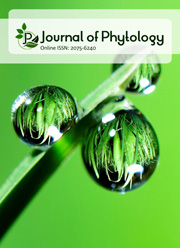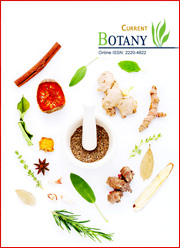High eggplant (Solanum aethiopicum L.) fruit intake for short duration enhances the antioxidant activity and biochemical parameters in rats
DOI:
https://doi.org/10.25081/jp.2024.v16.8962Keywords:
Solanum aethiopicum, Antioxidant, Hypolipidaemic, Lipid profile, Liver functionAbstract
Solanum aethiopicum is consumed in large quantities by various ethnic groups within Nigeria. This study evaluated the effect of S. aethiopicum fruit ethanol extract (SAFE) short-term intake at high doses on antioxidant and biochemical properties in rats. Thirty-six male Wistar rats were divided into six experimental groups. Two groups served as controls, while others were treated daily with graded doses of SAFE (500, 1000, 1500 and 2000 mg/kg b.w.) for fourteen days. Liver function, lipid profile, oxidative stress biomarkers, and liver pathology were assayed. Oral administration of SAFE significantly (p<0.05) reduced lipid peroxidation while increasing superoxide dismutase activity and glutathione concentration. Biomarkers of lipid profile and liver function were significantly (p<0.05) improved in SAFE-administered groups without altering the liver microarchitecture. The results suggest that short-term administration of S. aethiopicum fruit at high concentrations improves antioxidants and possesses hypocholesterolaemic properties without inducing hepatic alteration associated with its principles.
Downloads
References
Adelakun, S. A., Ukwenya, V. O., Akingbade, G. T., Omotoso, O. D., & Aniah, J. A. (2020). Interventions of aqueous extract of Solanum melongena fruits (garden eggs) on mercury chloride induced testicular toxicity in adult male Wistar rats. Biomedical Journal, 43(2), 174-182. https://doi.org/10.1016/j.bj.2019.07.004
Ademosun, O. T., Agwamba, E. C., Ahmad, I., Patel, H., Louis, H., Adebayo, A. H., & Ajanaku, K. O. (2024). Cytotoxic and phytochemical screening of Solanum lycopersicum–Daucus carota hydro-ethanolic extract and in silico evaluation of its lycopene content as anticancer agent. Open Chemistry, 22(1), 20230164. https://doi.org/10.1515/chem-2023-0164
Aja, P. M., Ale, B. A., Ekpono, E. U., Nwite, I., Aja, L., Asouzu, N. C., & Njoku, A. (2021). Amino acid profiles of Solanum aethiopicum, Amaranthus hybridus, and Telfairia occidentalis, common leafy vegetables in Nigeria. Science Progress, 104(3), 00368504211032079. https://doi.org/10.1177/00368504211032079
Ajanaku, C. O., Ademosun, O. T., Atohengbe, P. O., Ajayi, S. O., Obafemi, Y. D., Owolabi, O. A., Akinduti, P. A., & Ajanaku, K. O. (2022). Functional bioactive compounds in ginger, turmeric, and garlic. Frontiers in Nutrition, 9, 1012023. https://doi.org/10.3389/fnut.2022.1012023
Akinwunmi, K. F., & Ajibola, I. O. (2018). Evaluation of anti-obesity potentials of phenolic-rich fraction of Solanum aethiopicum L. and Solanum macrocarpon L. on diet-induced obesity in Wistar rats. European Journal of Medicinal Plants, 26(1), 1-10. https://doi.org/10.9734/EJMP/2018/45742
Aremu, M. O., Abeekaa, L. P., Zando, C., Obasi, B. C., Aremu, O. D., Passali, D. B., & Omotehinwa, F. H. (2023). Proximate, phytochemical and amino acid compositions of sodom apple (Calotropis procera) leaves and fruits. Lafia Journal of Scientific and Industrial Research, 1(1&2), 28-37. https://doi.org/10.62050/ljsir2023.v1n2.271
Buege, J., & Aust, S. (1978). Microsomal lipid peroxidation. Methods in Enzymology, 52, 302-310. https://doi.org/10.1016/S0076-6879(78)52032-6
Camillo, G. H. T. A., Bicas, J., & Junior, M. R. M. (2023). Nutritional benefits of fruit and vegetable beverages obtained by lactic acid fermentation. In M. Kuddus & M. Hossain (Eds.), Value-addition in beverages through enzyme technology (pp. 177-198). Cambridge, US: Academic Press. https://doi.org/10.1016/B978-0-323-85683-6.00002-8
Charlebois, S., Music, J., & Rupasinghe, H. P. (2023). Taking stock of fruit and vegetable consumption in Canada: Trends and challenges. Dietetics, 2(1), 23-33. https://doi.org/10.3390/dietetics2010002
Chinedu, S. N., Iheagwam, F. N., Anichebem, C. J., Ogunnaike, G. B., & Emiloju, O. C. (2017). Antioxidant and biochemical evaluation of Thaumatococcus daniellii seeds in rat. Journal of Biological Sciences, 17, 381-387.
Chinedu, S. N., Olasumbo, A. C., Eboji, O. K., Emiloju, O. C., Arinola, O. K., & Dania, D. I. (2011). Proximate and phytochemical analyses of Solanum aethiopicum L. Research Journal of Chemical Sciences, 1(3), 63-71.
Ding, Y., Hou, R., Yu, J., Xing, C., Zhuang, C., & Qu, Z. (2023). Dietary phytochemicals as potential chemopreventive agents against tobacco-induced lung carcinogenesis. Nutrients, 15(3), 491. https://doi.org/10.3390/nu15030491
Edeke, A., Uchendu, N., Omeje, K., & Odiba, A. S. (2021). Nutritional and pharmacological potentials of Solanum melongena and Solanum aethiopicum fruits. The Journal of Phytopharmacology, 10(1), 61-67.
Ekweogu, C. N., Ude, V. C., Nwankpa, P., Emmanuel, O., & Ugbogu, E. A. (2020). Ameliorative effect of aqueous leaf extract of Solanum aethiopicum on phenylhydrazine-induced anaemia and toxicity in rats. Toxicological Research, 36, 227-238. https://doi.org/10.1007/s43188-019-00021-5
Eze, S. O., & Kanu, C. Q. (2014). Phytochemical and nutritive composition analysis of Solanum aethopicum L. Journal of Pharmaceutical and Scientific Innovation, 3(4), 358-362. https://doi.org/10.7897/2277-4572.034172
Faraone, I., Lela, L., Ponticelli, M., Gorgoglione, D., De Biasio, F., Valentão, P., Andrade, P. B., Vassallo, A., Caddeo, C., Falabella, R., Ostuni, A., & Milella, L. (2022). New Insight on the bioactivity of Solanum aethiopicum Linn. Growing in Basilicata Region (Italy): Phytochemical characterization, liposomal incorporation, and antioxidant effects. Pharmaceutics, 14(6), 1168. https://doi.org/10.3390/pharmaceutics14061168
Gaspari, R., Aceto, P., Spinazzola, G., Piervincenzi, E., Chioffi, M., Giuliante, F., Antonelli, M., & Avolio, A. W. (2024). Blood purification in hepatic dysfunction after liver transplant or extensive hepatectomy: Far from the best-case scenarios. Journal of Clinical Medicine, 13(10), 2853.
Gürbüz, N., Uluişik, S., Frary, A., Frary, A., & Doğanlar, S. (2018). Health benefits and bioactive compounds of eggplant. Food Chemistry, 268, 602-610. https://doi.org/10.1016/j.foodchem.2018.06.093
Han, M., Opoku, K. N., Bissah, N. A. B., & Su, T. (2021). Solanum aethiopicum: The nutrient-rich vegetable crop with great economic, genetic biodiversity and pharmaceutical potential. Horticulturae, 7(6), 126. https://doi.org/10.3390/horticulturae7060126
Iheagwam, F. N., & Chinedu, S. N. (2022). Short-Term administration of Thaumatococcus daniellii (Benn.) Benth fruit pulp leads to dyslipidaemia and liver dysfunction in male Wistar rats. Journal of Pharmaceutical Negative Results, 13(14), 1280-1287.
Iheagwam, F. N., Iheagwam, O. T., Ogunlana, O. O., & Chinedu, S. N. (2023). Terminalia catappa leaf abrogates diabetes-induced dyslipidaemia in type 2 diabetic rats by upregulating lipid metabolic genes. Gene Expression, 22(3), 167-182. https://doi.org/10.14218/GE.2023.00053
Iheagwam, F. N., Iheagwam, O. T., Onuoha, M. K., Ogunlana, O. O., & Chinedu, S. N. (2022). Terminalia catappa aqueous leaf extract reverses insulin resistance, improves glucose transport and activates PI3K/AKT signalling in high fat/streptozotocin-induced diabetic rats. Scientific Reports, 12, 10711. https://doi.org/10.1038/s41598-022-15114-9
Iheagwam, F. N., Israel, E. N., Kayode, K. O., DeCampos, O. C., Ogunlana, O. O., & Chinedu, S. N. (2020). Nauclea latifolia Sm. Leaf extracts extenuates free radicals, inflammation, and diabetes-linked enzymes. Oxidative Medicine and Cellular Longevity, 2020, 5612486.
Le Turc, N., Silva, A. J., Florença, S. G., Raposo, A., Gonçalves, J. C., Lima, M. J., Teixeira-Lemos, E., & Guiné, R. P. F. (2024). Consumer knowledge about dietary relevance of fruits and vegetables: A study involving participants from Portugal and France. Nutrients, 16(2), 287. https://doi.org/10.3390/nu16020287
Lela, L., Russo, D., De Biasio, F., Gorgoglione, D., Ostuni, A., Ponticelli, M., & Milella, L. (2023). Solanum aethiopicum L. from the Basilicata region prevents lipid absorption, fat accumulation, oxidative stress, and inflammation in OA-treated HepG2 and Caco-2 cell lines. Plants, 12(15), 2859. https://doi.org/10.3390/plants12152859
Mbondo, N. N., Owino, W. O., Ambuko, J., & Sila, D. N. (2018). Effect of drying methods on the retention of bioactive compounds in African eggplant. Food Science and Nutrition, 6(4), 814-823. https://doi.org/10.1002/fsn3.623
Misra, H. P., & Fridovich, I. (1972). The role of superoxide anion in the autoxidation of epinephrine and a simple assay for superoxide dismutase. Journal of Biological Chemistry, 247(10), 3170-3175. https://doi.org/10.1016/S0021-9258(19)45228-9
Moraes, L. de L. S., Rodrigues, N. R., Dal Forno, A. H., Tambara, A. L., Boldori, J. R., Vizzotto, M., Quatrin, A., Emanuelli, T., & Denardin, C. (2023). Araçá (Psidium cattleianum Sabine) ethanol extracts increase lifespan and alleviate oxidative stress in Caenorhabditis elegans. Journal of Agriculture and Food Research, 11, 100505. https://doi.org/10.1016/j.jafr.2023.100505
Nimenibo-Uadia, R., & Omotayo, R. (2019). Comparative proximate, mineral and vitamin composition of Solanum aethiopicum and Solanum melongena. NISEB Journal, 17(3), 3.
Nwanna, E. E., Ibukun, E. O., & Oboh, G. (2019a). Eggplant (Solanum spp) supplemented fruits diet modulated the activities of ectonucleoside triphosphate diphosphohydrolase (ENTPdase), monoamine oxidase (MAO), and cholinesterases (AChE/BChE) in the brain of diabetic Wistar male rats. Journal of Food Biochemistry, 43, 12910. https://doi.org/10.1111/jfbc.12910
Nwanna, E. E., Ibukun, E. O., & Oboh, G. (2019b). Nutritional content of selected species of tropical eggplant fruit (Solanum spp) diet attenuates hepatic inflammation in high-fat fed male Wistar rats induced with streptozotocin. Food Science & Nutrition, 7(1), 109-119. https://doi.org/10.1002/fsn3.811
Nwanna, E. E., Ibukun, E. O., Oboh, G., Ademosun, A. O., Boligon, A. A., & Athayde, M. (2014). HPLC-DAD analysis and in-vitro property of polyphenols extracts from (Solanum aethiopium) fruits on α-amylase, α-glucosidase and angiotensin-1-converting enzyme activities. International Journal of Biomedical Science, 10(4), 272-281.
Ogunka-Nnoka, C. U., Onyegeme-Okerenta, B. M., & Omeje, H. C. (2018). Effects of ethanol extracts of S. aethiopicum stalks on lipid profile and haematological parameters of Wistar albino rats. International Journal of Science and Research Methodology, 10(3), 215-229.
Okesola, M. A., Ajiboye, B. O., Oyinloye, B. E., Osukoya, O. A., Owero-Ozeze, O. S., Ekakitie, L. I., & Kappo, A. P. (2020). Effect of Solanum macrocarpon Linn leaf aqueous extract on the brain of an alloxan-induced rat model of diabetes. Journal of Internal Medical Research, 48(6), 0300060520922649. https://doi.org/10.1177/0300060520922649
Onyenibe, S. N., Ifie, J., & Oriabure, E. A. (2022). Use of plant foods from West Africa in the management of metabolic syndrome. In R. B. Singh, S. Watanabe & A. A. Isaza (Eds.), Functional foods and nutraceuticals in metabolic and non-communicable diseases (pp. 107-120). Cambridge, US: Academic Press. https://doi.org/10.1016/B978-0-12-819815-5.00038-0
Ponticelli, M., Hidalgo-García, L., Diez-Echave, P., Vezza, T., Romero, M., Robles-Vera, I., Duarte, J., De Biasio, F., Gorgoglione, D., Lela, L., Galvez, J., & Milella, L. (2023). Solanum aethiopicum L. from the Basilicata region as a source of specialized metabolites with promising anti-obesity effects: Phytochemical characterization and in vivo investigation in high fat diet-fed mice. Frontiers in Pharmacology, 14, 1306135. https://doi.org/10.3389/fphar.2023.1306135
Sedlak, J., & Lindsay, R. (1968). Estimation of total, protein-bound, and nonprotein sulfhydryl groups in tissue with Ellman’s reagent. Analytical Biochemistry, 25, 192-205. https://doi.org/10.1016/0003-2697(68)90092-4
Serras, A. S., Rodrigues, J. S., Cipriano, M., Rodrigues, A. V., Oliveira, N. G., & Miranda, J. P. (2021). A critical perspective on 3D liver models for drug metabolism and toxicology studies. Frontiers in Cell and Developmental Biology, 9, 626805. https://doi.org/10.3389/fcell.2021.626805
Silva, G. F. P., Pereira, E., Melgar, B., Stojković, D., Sokovic, M., Calhelha, R. C., Pereira, C., Abreu, R. M. V., Ferreira, I. C. F. R., & Barros, L. (2020). Eggplant fruit (Solanum melongena L.) and bio-residues as a source of nutrients, bioactive compounds, and food colorants, using innovative food technologies. Applied Sciences, 11(1), 151. https://doi.org/10.3390/app11010151
Srivastav, A., Shukla, A. K., Kumar, M., Kumar, S., & Mishr, R. K. (2024). Nutraceutical bioactive compounds in fruits and vegetables. In R. K. Keservani, B. T. Tung, R. K. Kesharwani & E. D. Ahire (Eds.), Plant Metabolites and Vegetables as Nutraceuticals (p. 113). Florida, US: Apple Academic Press.
Tunwagun, A. D., Akinyemi, O. A., Ayoade, T. E., & Oyelere, S. F. (2020). Qualitative analysis of the phytochemical contents of different anatomical parts of ripe Solanum aethiopicum Linneaus fruits. Journal of Complementary and Alternative Medical Research, 9(3), 14-22. https://doi.org/10.9734/jocamr/2020/v9i330142
Vairetti, M., Di Pasqua, L. G., Cagna, M., Richelmi, P., Ferrigno, A., & Berardo, C. (2021). Changes in glutathione content in liver diseases: An update. Antioxidants, 10(3), 364. https://doi.org/10.3390/antiox10030364
Valduga, A. H., Mizobuti, D. S., Moraes, F. dos S. R., Mâncio, R. D., Moraes, L. H. R., Hermes, T. de A., Macedo, A. B., & Minatel, E. (2023). Protection of dystrophic muscle cells using Idebenone correlates with the interplay between calcium, oxidative stress and inflammation. International Journal of Experimental Pathology, 104(1), 4-12. https://doi.org/10.1111/iep.12463
Venkatesh, R., Kalaivani, K., & Vidya, R. (2014). Toxicity assessment of ethanol extract of Solanum villosum (Mill) on Wistar albino rats. International Journal of Pharma Sciences and Research, 5(7), 406-412.
Xie, P., Luo, H.-T., Pei, W.-J., Xiao, M.-Y., Li, F.-F., Gu, Y.-L., & Piao, X.-L. (2024). Saponins derived from Gynostemma pentaphyllum regulate triglyceride and cholesterol metabolism and the mechanisms: A review. Journal of Ethnopharmacology, 319, 117186. https://doi.org/10.1016/j.jep.2023.117186
Published
How to Cite
Issue
Section
Copyright (c) 2024 Franklyn Nonso Iheagwam, Shalom Nwodo Chinedu

This work is licensed under a Creative Commons Attribution 4.0 International License.





 .
.